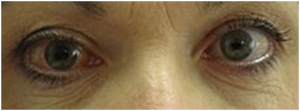Glaucoma is an eye condition that develops when too much fluid pressure builds up inside of the eye. It tends to be inherited and may not show up until later in life. Glaucoma tests are painless and take very little time. Treatments include eye drops, laser surgery and microsurgery.
Glaucoma is an eye disorder in which the optic nerve suffers damage, permanently impacting vision in the affected eye(s) and progressing to complete blindness if untreated. It is often, but not always, associated with increased pressure of the fluid in the eye (aqueous humour). The term ‘ocular hypertension’ is used for cases having constantly raised intraocular pressure (IOP) without any associated optic nerve damage. Conversely, the term ‘normal’ or ‘low tension glaucoma’ is suggested for the typical visual field defects when associated with a normal or low IOP.
The nerve damage involves loss of retinal ganglion cells in a characteristic pattern. There are many different sub-types of glaucoma but they can all be considered a type of optic neuropathy. Raised intraocular pressure is a significant risk factor for developing glaucoma (above 21 mmHg or 2.8 kPa). One person may develop nerve damage at a relatively low pressure, while another person may have high eye pressure for years and yet never develop damage. Untreated glaucoma leads to permanent damage of the optic nerve and resultant visual field loss, which can progress to blindness.
 Glaucoma can be divided roughly into two main categories, “open angle” and “closed angle” glaucoma. Closed angle glaucoma can appear suddenly and is often painful; visual loss can progress quickly but the discomfort often leads patients to seek medical attention before permanent damage occurs. Open angle, chronic glaucoma tends to progress at a slower rate and the patient may not notice that they have lost vision until the disease has progressed significantly.
Glaucoma can be divided roughly into two main categories, “open angle” and “closed angle” glaucoma. Closed angle glaucoma can appear suddenly and is often painful; visual loss can progress quickly but the discomfort often leads patients to seek medical attention before permanent damage occurs. Open angle, chronic glaucoma tends to progress at a slower rate and the patient may not notice that they have lost vision until the disease has progressed significantly.
Acute angle closure glaucoma
of the right eye.
Note the mid sized pupil, which was non-reactive to light, and injection of the conjunctiva
Glaucoma has been nicknamed the “silent thief of sight” because the loss of vision normally occurs gradually over a long period of time and is often only recognized when the disease is quite advanced. Once lost, this damaged visual field cannot be recovered. Worldwide, it is the second leading cause of blindness. It is also the leading cause of blindness among African Americans. Glaucoma affects 1 in 200 people aged fifty and younger, and 1 in 10 over the age of eighty. If the condition is detected early enough it is possible to arrest the development or slow the progression with medical and surgical means.
Management
 The modern goals of glaucoma management are to avoid glaucomatous damage, nerve damage, preserve visual field and total quality of life for patients with minimal side effects. This requires appropriate diagnostic techniques and follow up examinations and judicious selection of treatments for the individual patient. Although intraocular pressure is only one of the major risk factors for glaucoma, lowering it via various pharmaceuticals and/or surgical techniques is currently the mainstay of glaucoma treatment. Vascular flow and neurodegenerative theories of glaucomatous optic neuropathy have prompted studies on various neuroprotective therapeutic strategies including nutritional compounds some of which may be regarded by clinicians as safe for use now, while others are on trial.
The modern goals of glaucoma management are to avoid glaucomatous damage, nerve damage, preserve visual field and total quality of life for patients with minimal side effects. This requires appropriate diagnostic techniques and follow up examinations and judicious selection of treatments for the individual patient. Although intraocular pressure is only one of the major risk factors for glaucoma, lowering it via various pharmaceuticals and/or surgical techniques is currently the mainstay of glaucoma treatment. Vascular flow and neurodegenerative theories of glaucomatous optic neuropathy have prompted studies on various neuroprotective therapeutic strategies including nutritional compounds some of which may be regarded by clinicians as safe for use now, while others are on trial.
From Wikipedia, the free encyclopedia
Disclaimer
This information is presented for education purposes, to make it easy for you to explore your vision correction options. HOWEVER, no matter how reliable information on this or any website may be, there is no substitute for a professional examination of your eyes and a face-to-face discussion of your unique situation. If you are experiencing any difficulty with your vision, you should schedule an eye examination.

